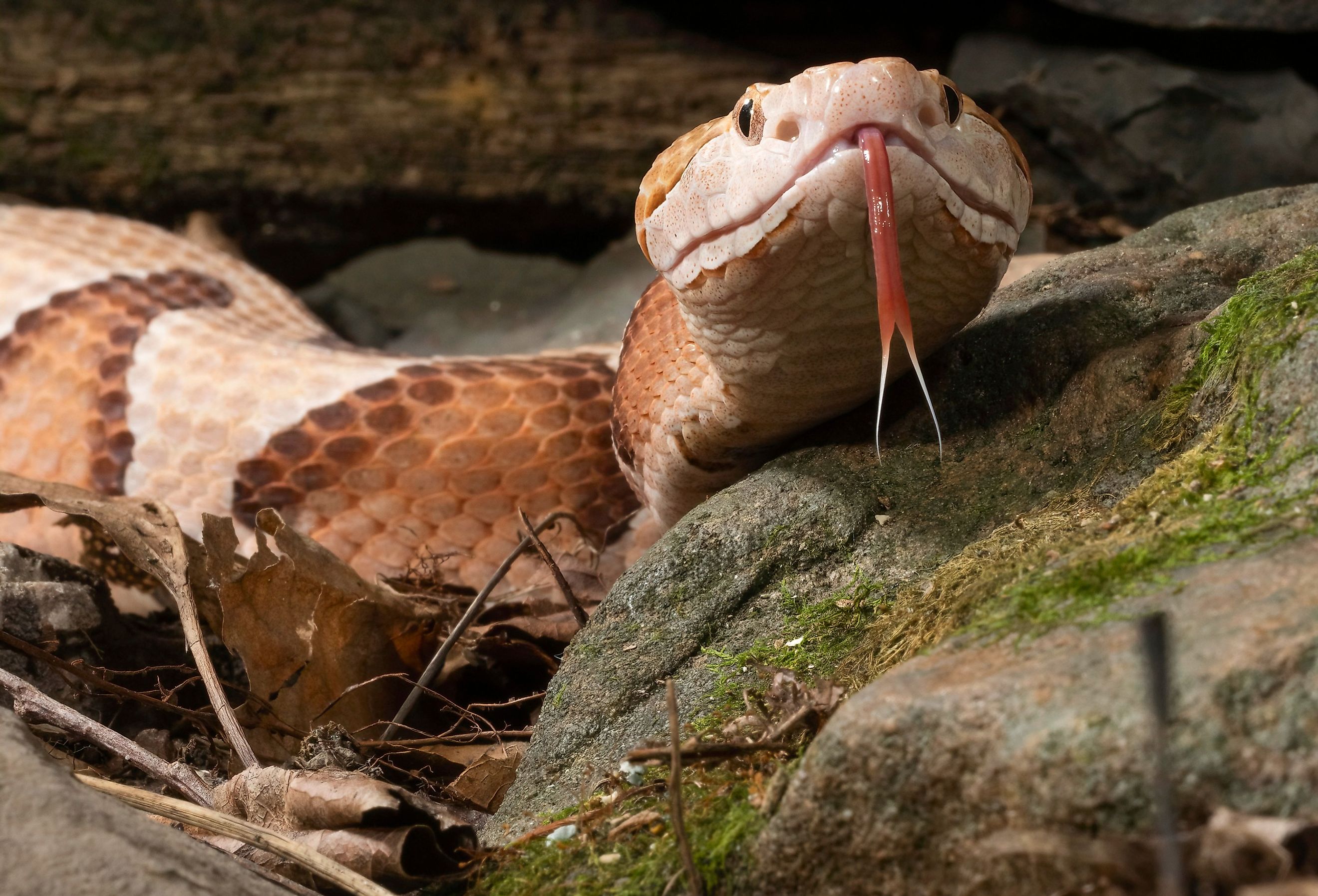
The 13 Deadliest Animals in Oklahoma
Oklahoma is a landlocked state surrounded by Missouri, Kansas, New Mexico, Arkansas, and Texas. It has diverse geological areas, ranging from the Great Plains to mountains such as the Ouachita Mountains, and plateaus like the Ozarks. With dense forests, wetlands, and rocky terrains, many animals call this state home. This includes white-tailed deer, bison, beavers, wild turkeys, and plenty more birds and reptiles. The state is also home to several poisonous, venomous, and territorial animals that can cause injury, and in some cases, death. Read on to discover the deadliest animals in Oklahoma.
Brown Recluse Spider

These light to dark brown spiders can often be confused with harmless spiders and aren't as common to see as some may think. As their name suggests, they are incredibly secretive and prefer to remain in hiding. They can commonly be found in quiet areas like attics and basements, wood piles, and under debris. One way to identify this spider is by the violin-shaped pattern on their backs.
Brown recluse spiders don't actively seek out people to bite, and if you do happen to be bitten, it is usually because you accidentally disturbed their hiding spot.
Bites can lead to lesions, and necrosis caused by enzymes in their venom. Other symptoms include flu-like complications, such as fever, chills, and nausea. Untreated bites can lead to infection, tissue damage, and organ damage to areas like the kidneys. It is best to seek medical treatment, even if you weren't sure your bite was caused by the brown recluse.
Western Diamondback Rattlesnake

These venomous creatures are found in many places across the United States and are characterized by the dark, diamond-shaped pattern running along their backs. Usually between 3 and 5 feet in length, they have been known to reach lengths of around 7 feet. They usually enjoy environments like deserts, grasslands, and rockier areas and can be found in cracks, burrows, or under debris.
Mostly nocturnal, these snakes will give off their iconic warning when threatened, which involves the shaking of their rattle on their tails.
If bitten, their venom releases hemotoxins into the puncture site, which can lead to tissue damage and blood clotting issues. You will notice pain, swelling, bruising, and bleeding. More serious symptoms can include nausea, vomiting, breathing troubles, and infection. The treatment for a diamondback bite is often an administration of anti-venom, given to you by a medical professional.
Black Widow Spider

Like the brown recluse, these spiders prefer darker, more hidden areas to build their webs and hunt. Their webs are usually not very organized and are created in corners or under debris.
Female black widow spiders are identified by the bright red hourglass-shaped mark on their backs, while the males have lighter markings. Females are also much larger than their male counterparts.
They aren't known to be outwardly aggressive, and will often only bite if threatened or surprised. Bite symptoms include severe pain, muscle cramps and spasms, and reactions like sweating, nausea, and occasionally breathing issues.
Black Bear
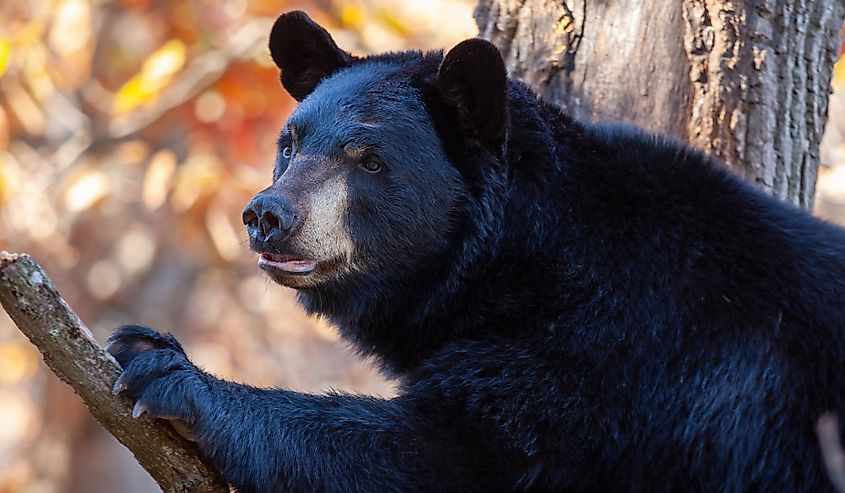
Black bears are common throughout North America. They have rounded ears, and stubby tails, and are smaller than their relatives, such as grizzlies and polar bears. Males are usually larger, but both can be aggressive, especially females with cubs.
They mostly inhabit mountainous areas, forests, and more densely covered regions. They are extremely active hunter-gatherers and can smell even the slightest scent of possible food. This is why you will often see warnings in parks to keep all food items locked up, and not to leave garbage lying around. Black bears have been known to drastically lose their fear of humans when they grow accustomed to an easily attainable food source, which can lead to their relocation, and sometimes even euthanasia.
Black bears are more of a threat to smaller animals and children than they are to adults, but can still pose a threat if you seem dangerous, or if you make a mama bear worry about her cubs. Bear maulings can be brutal, due to their large claws and strong teeth. If you happen to anger a black bear, make yourself appear larger, and make lots of noise to try and scare the animal off. Carry bear spray when in bear country.
Coyote
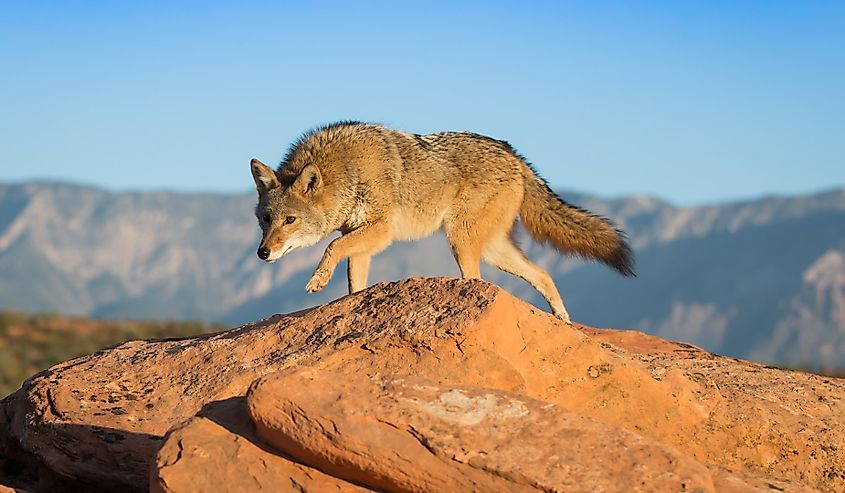
Coyotes like to travel in packs, which makes them all the more dangerous. Smaller than wolves, these predators are slim, with pointed ears and bushy tails. Coyotes, like black bears, will be tempted by the smell of left-out food, garbage, and small animals left to roam without supervision.
They like to hunt at night, and many people who live in areas with coyotes are familiar with their howls. Not usually a threat to humans, they sometimes attack if they feel like they have the upper hand. They are also sneaky and fast, and are even occasional spotted during the day.
Coyotes are more of a danger to animals such as cats and dogs. They are also a threat to small children and have also been known to nip at hikers, joggers, and people enjoying the parks. Coyotes are easily scared when confronted with something larger than them, which is why the best way to chase off these mammals is to stand your ground, yell, wave your arms, and make other loud noises.
Timber Rattlesnake
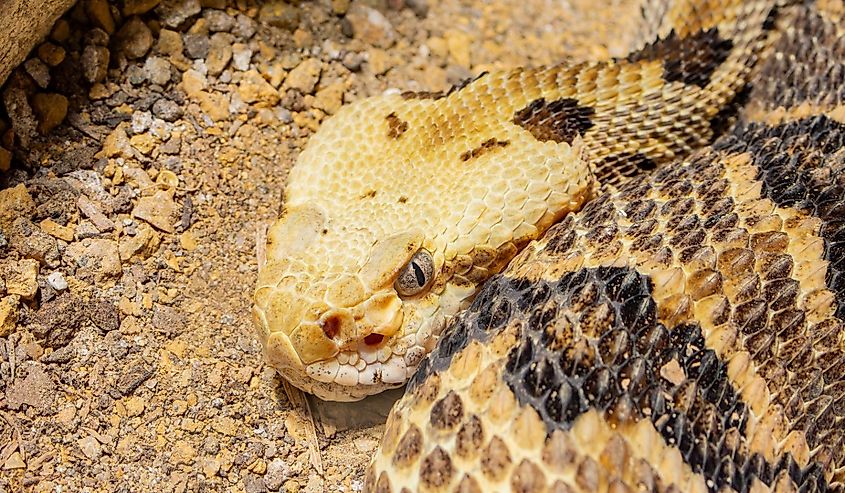
Characterized by their dark crossbands on a lighter-shade body, these rattlesnakes love to hide out in forests, rocky terrains, and places with lots of debris to hide under. They usually come out during the day, though when it gets hotter, tend to become more nocturnal.
They don't actively seek out larger prey such as humans, preferring to hunt small rodents. However, they will respond if threatened by shaking their rattle, and striking if you get too close. Their bites contain hemotoxins, which lead to tissue damage, severe bleeding, and swelling. Other bite symptoms include nausea, extreme pain, trouble breathing, and occasionally shock. Anti-venom is administered by a medical professional. So if bitten, it is recommended to seek help as soon as possible.
American Alligator
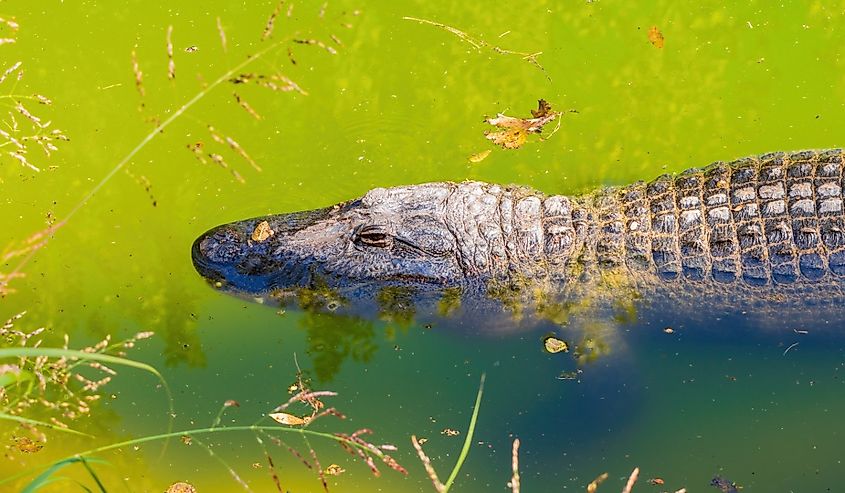
Alligators, sometimes confused with crocodiles, are round-snouted animals that frequent freshwater sources, such as lakes, rivers, and swamps. They have a darker back and a lighter-colored underbelly. Feasting on unsuspecting prey, alligators are patient hunters, often utilizing stalking methods and sudden attacks. You might not even know they are there until they have decided to strike.
Males are often bigger than females, reaching up to 15 feet long, while females can usually reach around 10 feet long.
Found in the southeastern parts of Oklahoma, alligators can become fearless around humans if they are fed, which can lead to more instances of attack. Do not feed alligators, or engage them in any way. Avoid areas where alligators like to live and don't allow children or pets near the shores or in the water.
Copperhead Snake
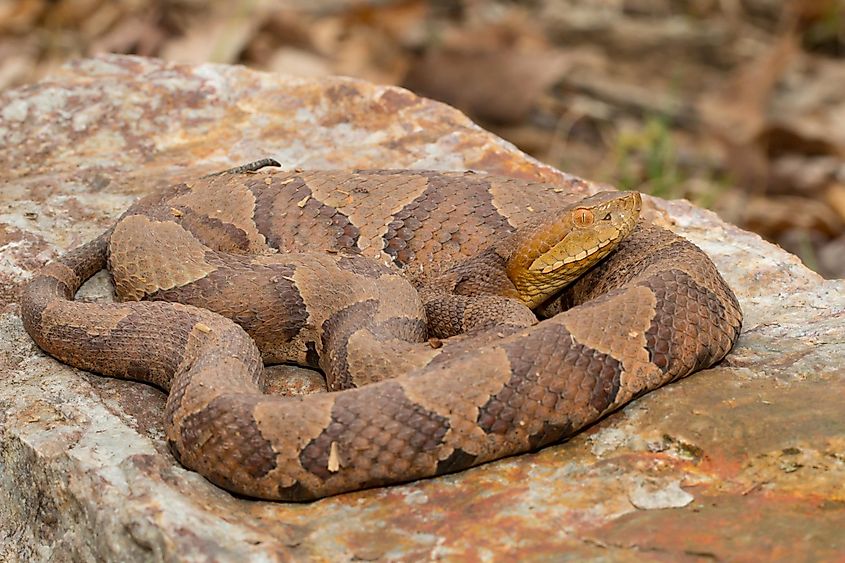
A type of pit viper, copperheads are found in the eastern and central parts of Oklahoma. They can be identified by their hourglass band pattern. They can be found in a variety of environments, so long as it has ample hiding opportunities. They are excellent at ambushing their prey, remaining motionless until it is time to strike. They also possess heat-sensing pits between their eyes and nostrils, which help sense warm-blooded animals.
While they don't often bite unless threatened, their bites contain hemotoxins, which can lead to clotting issues and tissue damage. Bites can also lead to pain, swelling, bruising, nausea, vomiting, and dizziness.
Cottonmouth Snake
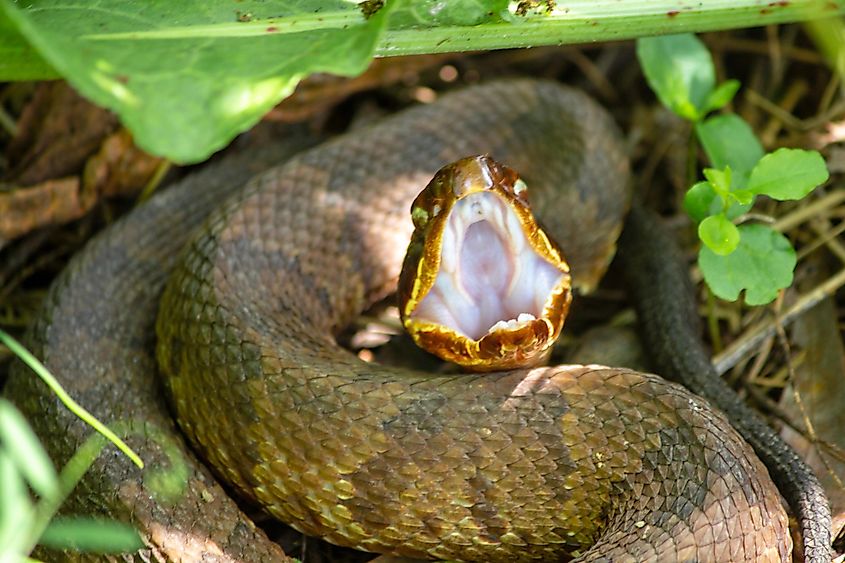
Cottonmouths, also known as water moccasins, are semi-aquatic snakes found in rivers, lakes, and other waterways. They are excellent swimmers but can hunt proficiently both in water and on land. They have thick, muscular bodies, and triangle-shaped heads. They range in size from 2.5 feet to 6 feet, with the males often being larger. They get their names from the white tissue displayed in their mouths when showing their fangs.
Cottonmouth bites release hemotoxins, which can cause bleeding, clotting issues, and necrosis of nearby tissue. Other symptoms include pain, swelling, bruising, and difficulty breathing. The best treatment for a cottonmouth bite is anti-venom administered by a medical professional.
Ticks
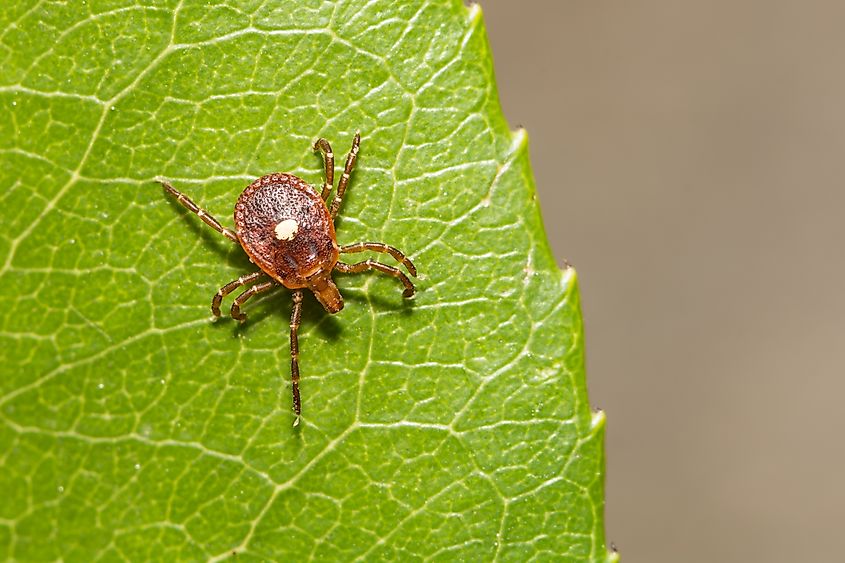
Ticks, although not inherently poisonous or venomous themselves, carry a whole slew of diseases.
The different types of ticks in Oklahoma include black-legged ticks, winter ticks, American dog ticks, brown dog ticks, lone star ticks, and Gulf Coast ticks.
Potential diseases carried by these ticks include Rocky Mountain Spotted Fever, which causes fever, chills, muscle aches, a spotty rash, and delirium. Another is, Lyme disease, characterized by a rash, flu-like symptoms, severe fatigue, and severe joint pain. Tularemia can cause a fever, lesions, conjunctivitis, enlarged lymph nodes, and pulmonary complications.
The best way to avoid tick exposure is to wear long clothes that cover your skin and to do thorough checks when you are done being outside in tick-infested areas, making sure to check hidden areas like the backs of knees and armpits. Try to save the tick for later identification if you do find one stuck to you.
Scorpion
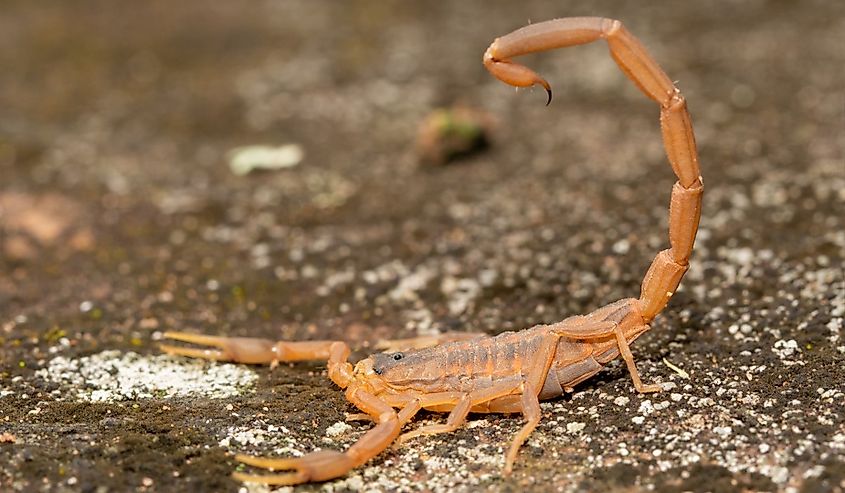
One of the main species of scorpion in Oklahoma is the striped bark scorpion. These creatures are characterized by the two dark stripes going lengthwise down their backs. They like hanging out in woodlands, grasslands, and places with debris that is good for hiding. This can include under logs rocks, and junk piles. These scorpions are mainly nocturnal, opting to hunt at night when there is less heat and other predators.
A sting from a scorpion can cause sharp pain, swelling, redness, a burning sensation, vomiting, and breathing issues. Reactions vary depending on your body and can progress to more severe symptoms.
A fun fact about scorpions is that, due to a chemical in their exoskeleton, they glow under ultraviolet light. If you possess a UV light and want to see how many are in the surrounding area, you can easily spot them when the sun goes down.
Mountain Lions
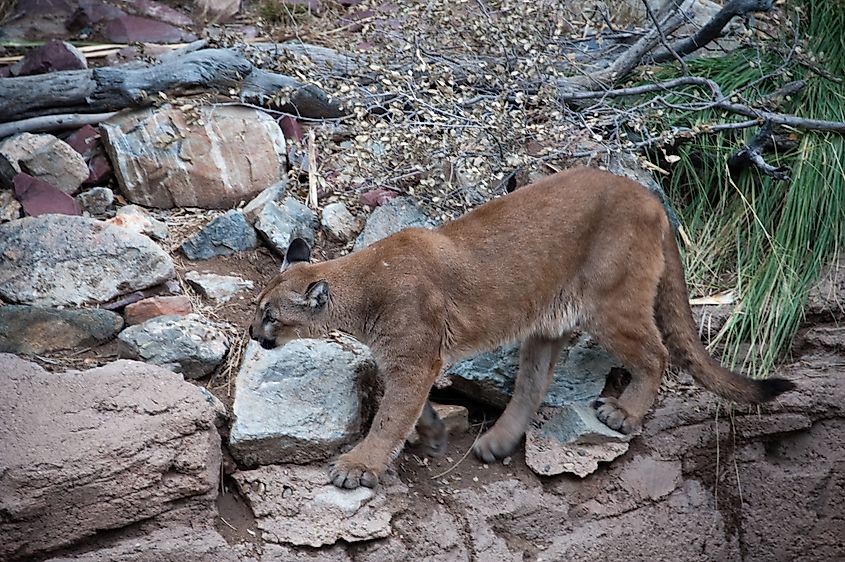
Mountain lions, also known as cougars, are solitary animals that possess extremely impressive stealth capabilities. They are good climbers, and highly adaptable to many different climates, including deserts, mountains, and forests. Most active during dawn, dusk, and overnight, these large cats hunt deer, raccoons, rabbits, and other smaller animals. They may also attack pets and small children if given the chance.
Mountain lions were once much more common to see in Oklahoma, but now you are unlikely to stumble across one, with only a few sightings a year. They will usually only attack adults when threatened or surprised, or if they see you as easy prey. To avoid a confrontation, make noise while hiking, and be aware of your surroundings. Keep pets and children close, and if approached by a mountain lion, stand your ground. Do not run, as this will activate a chase response. Appear bigger than you are, make lots of loud noises, and if the animal advances on you, throw objects such as rocks and sticks (near the animal, but not at it) to scare it off.
Western Pygmy Rattlesnake
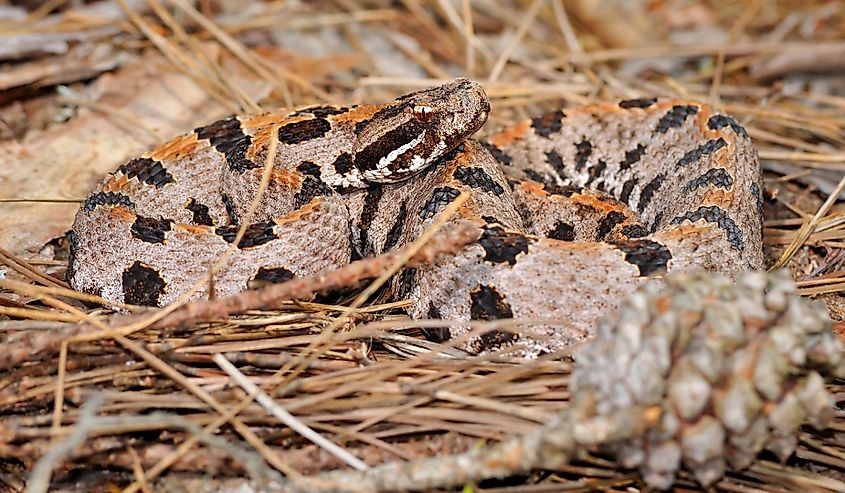
West pygmy rattlesnakes are a smaller type of rattlesnake that can be found in places with lots of dense ground cover. They can be identified by the dark blotches adorning their body, as well as a stripe going from their eye to their mouth. Because of their smaller size, their rattles are also smaller, and harder to hear, making a faint buzz rather than an easily identifiable rattle. They also possess excellent camouflage skills and can be hard to spot.
Bites from these snakes aren't as potent and severe as other rattlesnakes, but can still cause complications. Basic symptoms include pain, swelling, and tissue damage from the hemotoxins in their venom. Their bites can be taken care of with first aid practices, as well as an administration of anti-venom.
Conclusion
When visiting Oklahoma, or if you already call the state home, it's important to familiarize yourself with potentially dangerous wildlife. If spending time outdoors, whether hiking, playing, or working, be aware of your surroundings, and know how to deal with possible run-ins. This includes carrying bear spray and a cellular device, knowing important phone numbers, and knowing what to do if you are attacked. However, don't let these creatures deter you from enjoying everything Oklahoma has to offer. Just be cautious, smart, and prepared.











